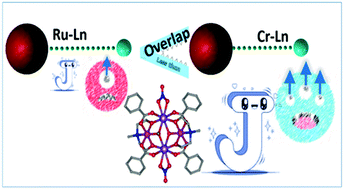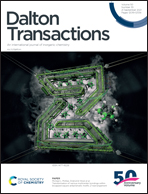Enhancing the barrier height for magnetization reversal in 4d/4f Ru III2Ln III2 “butterfly” single molecule magnets (Ln = Gd, Dy) via targeted structural alterations†
Abstract
A series of 4d–4f {RuIII2DyIII2} and {RuIII2GdIII2} ‘butterfly’ (rhombohedral) complexes have been synthesized and characterized and their magnetic properties investigated. Earlier, we have reported the first 4d/4f SMM – [RuIII2DyIII2(OMe)2(O2CPh)4(mdea)2(NO3)2] (1Dy) with a Ueff value of 10.7 cm−1. As the structural distortion around the DyIII centres and the RuIII⋯DyIII exchange interactions are key to enhancing the anisotropy, in this work we have synthesised three more {Ru2Dy2} butterfly complexes where structural alteration around the DyIII centres and alterations to the bridging groups are performed with an aim to improve the magnetic properties. The new complexes reported here are [Ru2Dy2(OMe)2(O2C(4-Me-Ph)4(mdea)2(MeOH)4], 2Dy, [Ru2Dy2(OMe)2(O2C(2-Cl,4,5-F-Ph)4(mdea)2(NO3)2], 3Dy, and an acac derivative [Ru2Dy2(OMe)2(acac)4(NO3)2(edea)2], 4Dy, where acac− = acetylacetonate, edea2− = N-ethyldiethanolamine dianion. Complex 2Dy describes alteration in the DyIII centers, while complexes 3Dy and 4Dy are aimed to alter the RuIII⋯DyIII exchange pathways. To ascertain the 4d–4f exchange, the Gd-analogues of 1Dy and 4Dy were synthesised [Ru2Gd2(OMe)2(O2CPh)4(mdea)2(NO3)2], 1Gd, [Ru2Gd2(OMe)2(acac)4(NO3)2(edea)2], 4Gd. Both ac and dc susceptibility studies were performed on all these complexes, and out-of-phase signals were observed for 3Dy in zero-field while 2Dy and 4Dy show out-of-phase signals in the presence of an applied field. Complex 3Dy reveals a barrier height Ueff of 45 K. To understand the difference in the magnetic dynamic behavior compared to our earlier reported {RuIII2DyIII2} analogue, detailed theoretical calculations based on ab initio CASSCF/RASSI-SO calculations have been performed. Calculations reveal that the JRu⋯Dy value varies from −1.8 cm−1 (4Dy) to −2.4 cm−1 (3Dy). These values are also affirmed by DFT calculations performed on the corresponding GdIII analogues. The origin of the largest barrier and observation of slow magnetic relaxation in 3Dy is routed back to the stronger single-ion anisotropy and stronger JRu⋯Dy exchange which quenches the QTM effects more efficiently. This study thus paves the way forward to tune local structure around the LnIII center and the exchange pathway to enhance the SMM characteristics in other {3d–4f}/{4d–4f} SMMs.

- This article is part of the themed collections: Spotlight Collection: Lanthanide and transition metal complexes as molecular magnets and Celebrating our Golden Authors


 Please wait while we load your content...
Please wait while we load your content...